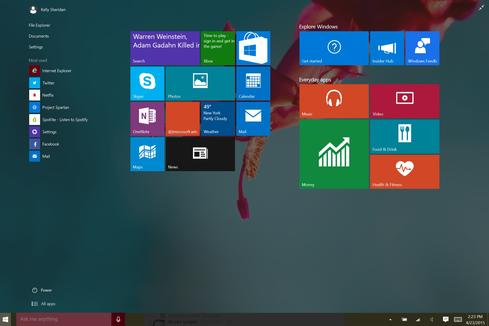Microsoft Band, Health Updates Look To Compete With Apple Watch
The Apple Watch is the focus on media attention this week, but Microsoft's Band update looks to challenge the device.


Windows 10 Build 10061: App Revamps Galore
Windows 10 Build 10061: App Revamps Galore (Click image for larger view and slideshow.)
Microsoft has upgraded its open Health platform and wearable fitness gadget Band as much of the attention today is focused on the Apple Watch and whether its release will start a new phase in the wearable and smartwatch markets.
The Microsoft Health platform is designed to combine data from a range of devices already deployed with health and fitness apps -- the company's update allows users to track daily steps and calorie burn inside of the app using the sensors contained in a wide variety of Android Phones, Apple's iPhone, and Windows Phones.
The update builds on Microsoft's Bike Tile, which was introduced in February, and expands cycling functionality through partnerships with Bike apps like MapMyRide and Strava.
As of this month Band customers will be able to wear their device during rides and to compare performance or share routes with other riders using these apps.
The Health app update means users will be able to access new insights and observations in the company's Web-based dashboard, such as comparative insights, which measure data such as daily steps, sleep, workout frequency, and calorie burn and compare the information to similar Health users based on body type, a combination of height and weight.
Microsoft noted that step-tracking capabilities are only supported through apps on the iPhone 5s and later, Android 4.4+ with support for Step Counter API, and Windows Phone Lumia devices with Sensor Core V1+ and Cyan FW.
Users can also deploy the Web dashboard to analyze sleep restoration, sleep efficiency, and wake-ups to find out how well the body restores its resources during sleep.
Microsoft also included Fitness Benefit, which measures progress using historical data to measure improvement over time, and VO2 Max, which refers to the maximum volume of oxygen used during exercise -- an indicator of cardiovascular fitness.
Additionally, the Run/Exercise Observations feature helps users maximize runs and workouts with analytics insights that, with a week of data, let them determine which day of the week and at what time of day they perform best.
Using historical data from as far back as five weeks, users can track whether they're maintaining, progressing, or need to redouble their efforts.
Users can also analyze their personal stats to find specific aspects of runs and workouts that can be improved.
[Read about the launch of the Apple Watch.]
"We encourage our customers to continue to provide feedback and responses to Microsoft Health and Microsoft Band and look forward to delivering even more to help our customers and partners live healthier and be more productive," Matt Barlow, general manager of new devices marketing at Microsoft, wrote on the company's blog.
The wearable fitness device market is under new scrutiny thanks to Apple's launch of its smartwatch, which promises to improve the market while adding personalized features.
In addition to the standard features fitness bands offer, Apple is doubling down with the HealthKit platform, designed to help doctors, other medical professionals, and scientists gather data more frequently and more accurately from participants using iPhone apps. The software enables researchers to contribute to specific activity modules in the framework, like memory-testing or gait-testing.
Interop Las Vegas, taking place April 27-May 1 at Mandalay Bay Resort, is the leading independent technology conference and expo series dedicated to providing technology professionals the unbiased information they need to thrive as new technologies transform the enterprise. IT Pros come to Interop to see the future of technology, the outlook for IT, and the possibilities of what it means to be in IT.
About the Author(s)
You May Also Like
How to Amplify DevOps with DevSecOps
May 22, 2024Generative AI: Use Cases and Risks in 2024
May 29, 2024Smart Service Management
June 4, 2024







